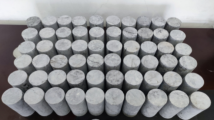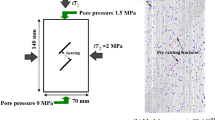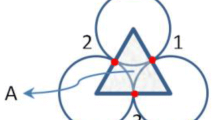Abstract
Discontinuities play a significant role in the analysis and design of rock structures, e.g., tunnels, stability of slopes, blocky rock masses, etc. Therefore, the following study is conducted using a discrete element method (DEM) model in Universal Distinct Element Code (UDEC) software which takes into consideration the discontinuities present in the material medium, both load-induced as well as inherent discontinuities. The DEM model in UDEC is used for the study to simulate the Uniaxial Compressive test response of Fresh Quartzite Rock. The Quartzite Rock is taken for this study because the same rock was encountered at a project site Saundatti, Karnataka, which has been identified as an amenable place to develop an integrated project by Greenko Group. In this study, all the laboratory experiments are performed on the Quartzite rock, and its behaviour is understood with those experimental results. Out of all the experiments, Uniaxial Compressive Strength (UCS) Test is chosen for the simulation purpose. The specimen model used for simulation of UCS is 110 mm in height and 54 mm in width. The specimen is further subdivided into around 900 smaller deformable blocks to simulate the field condition accurately. The model is bounded at the top and bottom by steel platens to ascertain relatively uniform load transfer across the specimen cross-section. The contact points between the deformable blocks are characterized with the normal and shear stiffness, with their nonlinear behaviour modelled from Mohr–Coulomb failure envelope (shear regime) and Rankine tension cutoff (tension regime). These micro-mechanical parameters to the DEM model are characterized by the obtained macro-level parameters from laboratory experiments. The simulation of UCS using UDEC is carried out to quantify the deformability characteristics, fracture patterns, and the stress–strain curve of the rock specimen. The deformability characteristics obtained from the numerical model are quite consistent with that of experimental observations and is mainly due to the precisely chosen micro-mechanical parameters. Moreover, the cracks initiation and propagation, stress profiles and deformation patterns obtained in the simulation are studied intricately.
Access this chapter
Tax calculation will be finalised at checkout
Purchases are for personal use only
Similar content being viewed by others
References
Zhao C, Niu J, Zhang Q, Yu S, Morita C (2019) Numerical simulations on cracking behavior of rock-like specimens with single flaws under conditions of uniaxial and biaxial compressions. J Mater Civ Eng 31:04019305. https://doi.org/10.1061/(asce)mt.1943-5533.0002967
Lisjak A, Grasselli G (2014) A review of discrete modeling techniques for fracturing processes in discontinuous rock masses. J. Rock Mech Geotech Eng 6:301–314. https://doi.org/10.1016/j.jrmge.2013.12.007
Zhang XP, Wong LNY (2012) Cracking processes in rock-like material containing a single flaw under uniaxial compression: a numerical study based on parallel bonded-particle model approach. Rock Mech Rock Eng 45:711–737. https://doi.org/10.1007/s00603-011-0176-z
Tang CA, Lin P, Wong RHC, Chau KT (2001) Analysis of crack coalescence in rock-like materials containing three flaws - Part II: numerical approach. Int J Rock Mech Min Sci 38:925–939. https://doi.org/10.1016/S1365-1609(01)00065-X
Hoek E, Martin CD (2014) Fracture initiation and propagation in intact rock - a review. J Rock Mech Geotech Eng 6:287–300. https://doi.org/10.1016/j.jrmge.2014.06.001
Prakash PR, Pulatsu B, Lourenço PB, Azenha M, Pereira JM (2020) A meso-scale discrete element method framework to simulate thermo-mechanical failure of concrete subjected to elevated temperatures. Eng Fract Mech 239:107269. https://doi.org/10.1016/j.engfracmech.2020.107269
Cundall AP (1971) A computer model for simulating progressive, large-scale movement in blocky rock system. In: Proceedings of the international symposium on rock mechanics 1971 (1971)
Kazerani T, Zhao J (2010) Micromechanical parameters in bonded particle method for modelling of brittle material failure. Int J Numer. Anal Methods Geomech 34:1877–1895. https://doi.org/10.1002/nag.884
Acknowledgements
This research work was supported by Civil Engineering Department of National Institute of Technology, Warangal, India. The authors would also like to express their sincere gratitude to the editor and anonymous reviewers for their valuable comments, which have greatly improved this paper.
Author information
Authors and Affiliations
Corresponding author
Editor information
Editors and Affiliations
Rights and permissions
Copyright information
© 2022 The Author(s), under exclusive license to Springer Nature Singapore Pte Ltd.
About this paper
Cite this paper
Ramana, G.V., Verma, J., Ravi Prakash, P. (2022). Testing and Numerical Simulations on Fracture Behavior of Fresh Quartzite Rock Using the Discrete Element Method. In: Tadepalli, T., Narayanamurthy, V. (eds) Recent Advances in Applied Mechanics. Lecture Notes in Mechanical Engineering. Springer, Singapore. https://doi.org/10.1007/978-981-16-9539-1_13
Download citation
DOI: https://doi.org/10.1007/978-981-16-9539-1_13
Published:
Publisher Name: Springer, Singapore
Print ISBN: 978-981-16-9538-4
Online ISBN: 978-981-16-9539-1
eBook Packages: EngineeringEngineering (R0)




